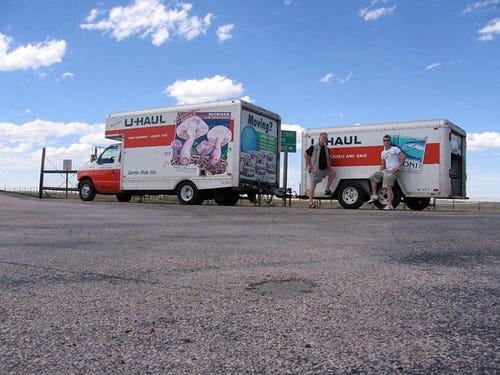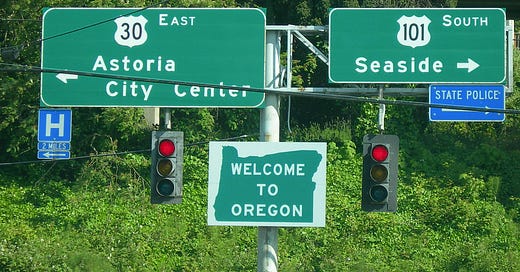Visit and stay. Please.
A new motto for a new era. For the foreseeable future, states will be in a competition for workers.
John Tapogna is President of ECONorthwest, an economic consulting firm with a headquarters in Portland and offices in Eugene and Bend. He moved to Oregon in 1978—following his two sisters. The opinions expressed here are his own.

2020 was filled with firsts. Here’s another one that economist Josh Lehner brought to our attention: for the first time in modern Oregon history, more people died than were born. As demographers put it, the state’s natural rate of population growth went negative.
Covid-19 deaths played a role, but they really just accelerated a trend that was already underway. Before the pandemic, demographers projected deaths would overtake births beginning later this decade. And, 19 counties—from Clatsop to Harney and Curry to Wallowa—recorded negative natural rates of population growth years ago.
Deaths outnumbering births means that, if the state fails to attract in-migrants in coming years, Oregon’s population and economy would gradually decline. It’s a wakeup call for anyone interested in a prosperous, dynamic future.
So, now’s a good time to reflect on Governor Tom McCall’s famous interview from 50 years ago. “Come visit us again and again. This is a state of excitement,” he told CBS News’ Terry Drinkwater. “But for heaven’s sake, don’t come here to live.”
Put more succinctly: Visit, but don’t stay. And McCall was serious. A few months after the CBS interview, he told a group of Manhattan executives that Oregon was accepting a few applications from a screened set of corporations that valued the sanctity of the environment. A decade later he was still largely unapologetic as he joined Governor Vic Atiyeh to post a friendlier sign at the California border.[1]
Oregonians who love this place should be forever grateful to McCall for bucking the smokestack chasing trends of his day, inspiring a deep commitment to the environment, and enacting legal and regulatory frameworks that cleaned our rivers, cleared our skies, and protected our open spaces. Today, you can safely jump in the Willamette River near the Tom McCall Waterfront Park and watch bald eagles fly over downtown Portland—just two small examples of his unrivaled legacy.
Oregonians also should be grateful that no one took McCall’s request literally. In fact, biographer Brent Walth argues McCall’s interview had just the opposite effect—boosting the state’s profile and sparking a decade of in-migration. The numbers back him up. The state’s population grew 26 percent during 1970s fueled by a massive influx of 25-39 year-olds. Oregon’s BIPOC population nearly doubled during the 1970s, which kickstarted five decades of diversification that has made the state more innovative, globally networked, economically dynamic, and culturally rich.
Oregon’s innovation streak started with a swoosh. It was 1971 when Blue Ribbon Sports formally split from Tiger and ultimately won the right to sell a new line of shoes they called “Nike.” Just three years later Intel broke ground on Fab4 in Aloha—its first campus outside of California. The two companies, and the robust industry clusters that have grown up around them, opened a new chapter in the state’s economic history. Many of their world-class engineers and designers have come from other states and countries. They visited and stayed, and the state is in a much stronger economic and fiscal position today as a result.
Oregon got to have its cake and eat it too. McCall fiercely defended our natural endowment in an era of clear cuts, toxic rivers, and polluted skies. And millions of talented people, most of whom shared his values and vision, moved here and called Oregon home. We grew our economy without ruining the place.
“Visit, but don’t stay” served an important values-signaling purpose then and now, but new demographic realities demand a more welcoming posture to ensure Oregon can continue to attract and retain talented and diverse individuals from across the US and around the world.
Oregon’s not alone in facing a demographic reckoning. The 2010s saw the lowest population growth in U.S. history. Our country is old, birth rates are on the decline, and immigration reform has been stalled for more than a decade. Demographers predict population stagnation until immigration returns to healthier levels, which requires less polarized politics.
So, for the foreseeable future, states will be in a competition for workers. Maine, which doesn’t have enough young workers to provide care for its aging population, is a postcard from the future. That future is becoming a reality for much of the country. Eighty percent of U.S. counties lost prime age workers (aged 25-54) during 2007-2017, and 65 percent will again during this decade. And leading labor economists argue that workforce shortages are a bigger concern than job-killing robots.
This is not 1971. When McCall issued his quip, he likely didn’t have jingoism, polarization, and automation top of mind; leaders today don’t have that luxury.
The bottom line: a state that has successfully executed McCall’s natural capital strategy—preserving the pristine wilderness and access to the outdoors that keep so many of us here and draw people from all over—needs to add a similarly coherent human capital strategy—attracting the best and brightest, as well as educating and retraining those already here—going forward. That starts with turning McCall’s unofficial motto on its head: visit and stay, please.
A more welcoming posture wouldn’t mean we’d walk away from our environmental values. But it would mean we’d deliver on our nation-leading housing reforms. We’d advance our work on social justice to make the state more welcoming to people of color. We’d lure remote workers out of high-priced, neighboring states. We’d leverage our leadership in age-friendly urban design to attract senior talent. And we’d ensure our new $1 billion-per-year PreK-12 investments make our schools the envy of the country.
An inclusive, welcoming posture takes courage. But we’ve had fifty years to figure out how to balance place and people, and we’re better at it than most states. That balance has been maintained thanks to communities in every corner of Oregon planning for growth with our natural capital in mind. We should not lose focus on that balance, but we must also recognize that this is not 1971. It’s time to crack open the door. Our economic future depends on it.
[1] For those interested in more on McCall’s interview, see Brent Walth’s Fire at Eden’s Gate, Part Four.
********************************************
Connect with John:
@tapogna
Keep the conversation going:
Facebook (facebook.com/oregonway)
Twitter (@the_oregon_way)




I'm wondering whether the bright side of a declining working age population will help raise wages and incomes for working people, both through government policies (minimum wage, child care subsidies etc.) and through market forces (with or without increased unionization). I've always been intrigued about the effects on labor markets from the plagues of the 1300s in Europe, which forced a dramatic increase in wages and fruitless attempts by elites to enact maximum wage laws in Britain. There are countless other examples from wars and other catastrophic events. But will demographic decline have the same effects?